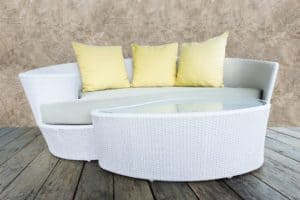As the old saying goes, “healthy body, healthy mind.” Using an air purifier in the right location can improve your sleeping environment to be clean and comfortable.
Air purifiers are great for keeping your bedroom’s air quality clean, whether you’re suffering from allergies or just want to sleep better.
In this article, we’ll cover the basics of how to use an air purifier in the bedroom: location, duration, direction and maintenance.
So let’s dive right in!
Setting Up Your Air Purifier

Ah, the joy of setting up an air purifier in your bedroom! Nothing makes you feel more like a DIY expert than unpacking the box, plugging it in and watching that little fan whir to life.
Now all you need is to position it for maximum efficiency!
But before we get too far ahead of ourselves, let’s take a look at what you need to do:
- Location – Where should you place your air purifier?
- Duration – How long should the air purifier be running?
- Direction – What direction does the air purifier need to face?
- Maintenance – How often should you clean and replace filters?
Let’s start with location: the best place for your air purifier is near any sources of pollution in your bedroom such as windows and doors.
This way, it can capture airborne particles and reduce odors before they spread through the room.
Meanwhile, position it away from furniture and curtains so air can circulate freely around it.
Next up is duration: depending on how polluted or smoky your surroundings are, you may want to leave your air purifier running all day or just when needed (e.g., when cooking).
To get an accurate reading of the quality of air in your bedroom, use a quality monitoring device; this will help you decide how long you need to keep it on for optimum performance.
Finally, direction: depending on where you place your unit, point it towards a wall or corner so that all corners of your bedroom receive purified air evenly.
Also, be sure to check manufacturer guidelines for specific directions on how to install and maintain your model—this will help ensure its longevity while delivering maximum efficiency!
Positioning Your Air Purifier For Maximum Efficiency
The positioning of an air purifier is like a game of chess – it requires careful consideration and strategy.
Each move must be made with purpose and precision to ensure maximum efficiency.
And just like the chess board, the bedroom is a critical space that needs to be filled in with each piece of the puzzle to get the desired outcome.
Just like in chess, there are no hard and fast rules when it comes to placing an air purifier in the bedroom; instead, you must make your own best judgement based on the size and shape of your room.
Generally speaking, placing your air purifier near windows or doors where outside air enters will help it work better as it can quickly clean out any pollutants entering the room.
Positioning it further away from furniture or walls can also help increase its effectiveness by allowing more air flow around it.
It’s important to remember that while proper placement can maximize efficiency, regular maintenance is equally important for ensuring that your air purifier works at its best.
Cleaning or replacing filters regularly will help keep them working properly and will help reduce energy consumption as well as extend their lifespan.
Now that you know how to position your air purifier for maximum efficiency, it’s time to establish a run time for it so you can get optimal results with minimal effort.
Establishing A Run Time For Your Air Purifier

Establishing a run time for your air purifier is like setting the clock of your home. It’s an important step in achieving optimal air quality.
The timing needs to be precise, so that your air purifier can do its job efficiently.
When it comes to runtime, there are a few key things you should consider. First and foremost, how long is the run time?
Generally speaking, longer is better when it comes to eliminating pollutants from the air.
However, if you have allergies or other health concerns, it’s best to stick with shorter durations as well as an increased frequency of use.
Additionally, you should also consider any special features included with your unit such as a timer or auto shut-off feature.
It’s also important to keep in mind that while running time is important, maintenance and noise level are equally critical considerations when choosing an air purifier for your bedroom.
Taking all these factors into account will help ensure that you get the most out of your device and enjoy clean air for years to come.
With proper care and attention, your bedroom can become a peaceful refuge where everyone can breathe easy.
Considering The Noise Level
The hum of the air purifier is like a lullaby, soothing and reassuring. It’s almost an invisible presence, silently but powerfully working its way to rid the room of dust, odors and allergens.
But you’ll need to consider a few factors before deciding on an air purifier for your bedroom.
One of those factors is noise level.
A low-noise purifier can be essential when you’re sleeping — no one wants to be woken up every hour by a loud humming motor!
So make sure you check the decibel rating of any air purifiers before you buy them, as this will tell you how loud they are at different speeds.
You should also look for models that feature adjustable fan speeds and settings so you can regulate the noise levels even further.
That way, you can keep your bedroom peaceful and serene while still enjoying the benefits of clean air.
To ensure that your air purification system works effectively, it’s important to establish a run time that fits smoothly into your lifestyle.
Cleaning The Air Purifier Regularly

Maintaining your air purifier is like lacing up a pair of shoes; taking it off and putting it back on isn’t enough.
Regular cleaning ensures that your air purifier will keep working optimally and efficiently, reducing the amount of allergens, dust and pet dander in your bedroom.
Cleaning your air purifier is a simple task.
It only needs to be done every couple weeks or so. When you do clean it, make sure you unplug the machine first to avoid any electrical shocks or malfunctions.
Then, vacuum the outside components with a soft brush attachment, followed by wiping them down with a damp cloth.
Afterwards, use a small paintbrush to remove any dust build-up from the fan blades and motor vents.
Finally, check for any debris caught in the filter and remove it if necessary.
By following these steps regularly, you can rest assured your air purifier will remain in good working order and keep your bedroom environment clean and healthy.
Changing The Filter Of Your Air Purifier
Changing the filter of your air purifier is key to its effectiveness. Doing this regularly ensures any airborne pollutants are removed quickly and efficiently.
But when should you change it?
It depends on the type of filter used and how often you use the purifier.
Most filters last between 3-6 months, but check with your manufacturer for specific instructions. You’ll also want to inspect the filter every few weeks to make sure it’s not clogged with debris.
When changing the filter, take special care to follow all safety guidelines.
Wear gloves and a mask if needed, as some filters can be dusty or contain allergens.
Once the new filter is in place, turn on the device and test its performance. Make sure you’ve done everything correctly so that your purifier runs at optimal levels.
Keeping Your Air Purifier In Good Working Order
Maintaining your air purifier is key to its performance. To keep it running smoothly, regular maintenance is required.
This includes checking the filter for signs of wear or tear and replacing it when necessary.
You should also clean your air purifier regularly with a damp cloth or vacuum attachment as directed by the manufacturer.
Using your air purifier in an optimal way can also help you get the most out of it.
Make sure to use it in an open space and not too close to furniture or walls so that it can draw in enough air for efficient filtration.
Additionally, consider setting up a timer so that you can run your air purifier for several hours at a time without having to manually turn it on and off.
Good maintenance practices will go a long way towards ensuring that your air purifier works as well as possible and lasts longer than expected.
Without proper care, you may find yourself troubleshooting common issues more often than necessary – something you don’t want to deal with unnecessarily.
So take the time to look after your air purifier, and you’ll be rewarded with cleaner air in no time!
Troubleshooting Common Air Purifier Issues
It’s estimated that nearly 60% of Americans have an air purifier in their homes. Air purifiers are a great way to improve the air quality in your home and keep it fresh, but sometimes they can experience issues.
Firstly, check if the filter needs to be changed. If your air purifier isn’t working as well as it used to, the filter could be clogged with dust and other particles and need replacing.
It’s important to replace the filter regularly (usually every 3-6 months).
If the filter is fine, check if there are any obstructions hindering airflow.
Move furniture away from the unit and make sure the vents are not blocked by curtains or other objects.
Also make sure that nothing is blocking the fan blades inside the system; debris can stop them from spinning freely and reduce efficiency.
Finally, test the power cord and switch.
If they’re faulty, you may need an electrician to help you repair or replace them safely. It’s also worth checking your user manual for any additional tips on cleaning or maintenance that you can carry out yourself; this will help keep your air purifier running more smoothly for longer!
Frequently Asked Questions
How Often Should I Replace My Air Purifier Filter?
Replacing your air purifier filter might seem like an impossible feat, but it’s essential for keeping your bedroom air clean and healthy. How often you need to change the filter depends on the type of air purifier and how much dust and dirt is in the air.
But no matter what, it’s always wise to stay up-to-date with your filter changes! You should be changing your air purifier filter at least every three months. If you have pets or if there’s a lot of dust in the room, you may have to replace it more frequently.
It’s also important to check your filter regularly for any signs of damage or wear and tear. You can do this by taking off the cover and inspecting the filter itself. If there are any tears or holes, it’s time to get a new one!
Maintenance is key when it comes to using an air purifier in the bedroom. Regularly replacing your filter will ensure that you’re getting the best results from your device and that your air remains fresh and clean. It may seem like a hassle but trust us – it really pays off!
How Much Energy Does An Air Purifier Use?
An air purifier can be a fantastic addition to any bedroom. But how much energy does it use? Allusion can help us answer this question. In the same way a car needs fuel, an air purifier needs energy to run.
The amount of energy used by an air purifier depends on its type and size. An HEPA filter, for example, uses more power than an ionizer. The bigger the room, the more powerful the machine needs to be; otherwise it won’t be able to clean the air effectively.
It’s also important to note that air purifiers often have multiple settings. If you choose a lower setting, your machine will consume less electricity than if you choose a higher setting.
However, while this may save money in the short-term, it won’t be as effective at removing airborne particles from your home.
The best approach is to find a model that strikes a balance between performance and cost-effectiveness. Air purifiers are efficient and easy to use—but they do require some energy to run properly.
By understanding their power requirements and finding a model that works for your needs, you can ensure that your air purifier is both effective and budget-friendly!
Are There Any Health Risks Associated With Air Purifiers?
The silence of the bedroom is broken by the gentle hum of an air purifier – a reassuring presence, its soft vibrations a reminder of our own safety and security. But are there any health risks associated with air purifiers?
We know that air pollution can cause numerous health issues, such as asthma and allergies. We also know that air purifiers can help reduce these risks. But what about the purifiers themselves? Could they bring unwanted harm?
Let’s take a closer look:
1. Air purifiers use electricity to run their filtration systems, but this does not typically pose a health risk.
2. Some air purifiers release ozone, which can be hazardous when inhaled in large quantities. Make sure to check the product specifications before buying an air purifier to ensure it does not produce ozone.
3. Air purifiers may also contain chemicals or fragrances that could trigger allergies or asthma symptoms. Again, read the product label carefully to make sure it suits your needs.
When used correctly, an air purifier can be a great way to protect yourself from airborne contaminants and enjoy clean, healthy air in your bedroom. However, it’s important to do your research before purchasing one so you can make sure it won’t harm you or your family’s health in any way!
Are Air Purifiers Safe To Have Running While Sleeping?
When looking to improve air quality, many of us turn to air purifiers. But with their constant humming and occasional flashing lights, are they safe to have running while sleeping?
Like the answer to many questions, it depends on the specific circumstances.
When used correctly, air purifiers can be a great way to improve overall air quality in a room – especially if someone is dealing with allergies or asthma. Most modern models come with timers and sensors that make them quieter and more efficient than ever before. But even so, some people find them too intrusive for comfortable sleep.
The best way to make sure an air purifier isn’t disrupting your sleep is by taking the time to set it up properly. If you’re dealing with allergies or asthma, place the unit near where you’ll be sleeping so that it can take care of any airborne irritants quickly.
Make sure you position it away from any sources of noise like fans or air conditioning units. This will help ensure that the device will be quiet enough not to keep you up at night.
TIP: Always read through your manual carefully before setting up your purifier in your bedroom, as different units may have different instructions and safety precautions to follow.
Conclusion
The air purifier is a great tool to have in the bedroom.
It can help you breathe easier and keep the air clean. With proper maintenance and regular filter replacement, it will serve you well for years to come.
It’s important to remember that air purifiers are not a cure-all.
They won’t magically remove all allergens from the air, but they can be incredibly helpful in limiting your exposure to airborne irritants.
Having an air purifier running while you sleep is generally considered safe as long as it’s maintained properly and kept clean.
With its gentle hum and steady flow of clean air, it can provide peace of mind knowing that you’re breathing in cleaner, healthier air.





